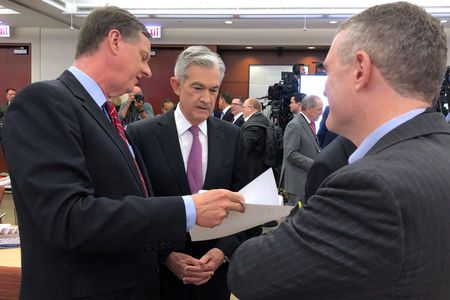

By Howard Schneider
New York (Reuters) -When the Federal Reserve tacked to a new brand of monetary policy 18 months ago it thought it could deliver low unemployment and tame inflation.
It may end up with neither, five top bank and academic economists wrote in a critique released on Friday.
Their paper envisions a scenario in which Fed Chair Jerome Powell and his colleagues are unable to control rising prices and forced to raise interest rates so high the economy slows and unemployment rises, hurting the very people they aimed to help.
“Avoiding downturns is as important as any gains” that workers might enjoy during a “hot economy”, one of the authors, Deutsche Bank Securities chief economist Peter Hooper said at a symposium where the paper was presented.
It was released at a time of flux in Fed policy, with the Fed expected to begin raising interest rates in March in response to high inflation, but still debating how aggressive it may need to be.
One Fed official responding to the paper said it was still likely inflation will ease over time without putting the recovery at risk.
“I see our current policy situation as likely requiring less ultimate financial restrictiveness compared with past episodes and posing a smaller risk,” Chicago Fed president Charles Evans said. “We don’t know what is on the other side of the current inflation spike… We may once again be looking at a situation where there is nothing to fear from running the economy hot.”
But others were skeptical that the new approach, dubbed the “Powell paradigm” by the writers, would work in its approach of using looser policy and allowing slightly higher inflation to encourage stronger employment.
The perceived benefits were valid, the authors found, with periods of low unemployment helping narrow the persistent gaps between, for example, white, Black and Hispanic workers, and between those with more education versus those with less.
But the COVID-19 pandemic and the policy responses to it have now “upended some of the premises” on which the new approach rested and left the Fed facing inflation not seen since the 1980s, wrote Hooper, Morgan Stanley’s Seth Carpenter, Bank of America’s Ethan Harris, University of Chicago professor Anil Kashyap, and University of Wisconsin professor Kenneth D. West.
They said the Fed may be able to lower the pace of price increases with steady but ultimately modest increases to its benchmark overnight interest rate, from near zero to around 3% between now and 2024, without triggering big changes in the unemployment rate – the ideal scenario for policymakers.
Favorable public psychology, with firms and households acting as if inflation will remain under control, does “most of the work … Therefore, the Fed neither has to be pre-emptive in heading inflation off nor does it have to crush the economy” to win back control, the group wrote.
But under some of the simulations they developed the Fed could be forced to raise interest rates perhaps twice as high, see inflation remain elevated, and the unemployment rate get lodged between 5% and 6% for several years.
That would be a blow to Fed hopes for a “broad and inclusive” recovery in the U.S. labor market, with the higher unemployment rate falling hardest on racial and ethnic minorities and less educated Americans.
The results “raise some questions for the Federal Reserve going forward” if, after promising it could deliver stable inflation and low unemployment, policymakers again have to make a choice.
“Either outcome, exacerbating inequality or accepting years of high inflation, is fraught with political risk,” they concluded.
BROADENING INFLATION
The Fed is due to hike interest rates at its March 15-16 policy meeting. Yet minutes of the central bank’s most recent discussion in January acknowledge the gamble officials took by leaving ultra-loose monetary policy, of near-zero interest rates and monthly purchases of bonds, in place as long as it did.
Inflationary forces that had been seen as “transitory” were now broadening through the economy, the minutes noted, and had begun influencing business investment and wage decisions in ways that could persist.
That’s the sort of dynamic that Carpenter, Harris and the other authors noted could force the Fed into tougher policy choices: If recent inflation experience informs what businesses or households expect to happen in the future and how they invest and spend as a result, it might require more aggressive rate increases – and worse employment outcomes – to reverse that thinking.
The emphasis on jobs “has potentially earned the Fed some good will,” the authors said. “But when the next recession comes and inequality rises … what will be the fallout?”
(Reporting by Howard SchneiderEditing by Paul Simao and Philippa Fletcher)

